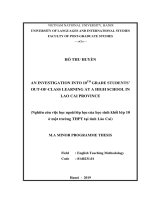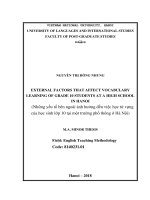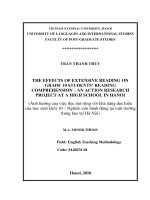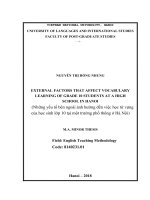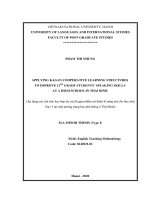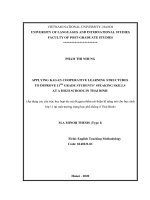Applying flip teaching method to improve students’ active learning at a high school in hanoi
Bạn đang xem bản rút gọn của tài liệu. Xem và tải ngay bản đầy đủ của tài liệu tại đây (1.36 MB, 82 trang )
VIETNAM NATIONAL UNIVERSITY-HA NOI
UNIVERSITY OF LANGUAGES AND INTERNATIONAL STUDIES
FACULTY OF POST GRADUATE STUDIES
LÊ THỊ MAI HOA
APPLYING FLIP TEACHING METHOD TO IMPROVE STUDENTS’
ACTIVE LEARNING AT A HIGH SCHOOL IN HANOI
Áp dụng phương pháp dạy học đảo chiều để cải thiện việc học chủ động của học
sinh tại một trường trung học phổ thông ở Hà Nội
Major: English Teaching Methodology
Supervisor: Dr. Huynh Anh Tuan
Hanoi - 2021
CERTIFICATE OF ORIGINALITY
I, the undersigned, hereby certify my authority of the study project report entitled
APPLYING FLIP TEACHING METHOD TO IMPROVE THE STUDENTS‟
ACTIVE LEARNING AT A HIGH SCHOOL IN HANOI submitted in partial
fulfillment of the requirements for the degree of Master in English Linguistics. Except
where the reference is indicated, no other person‟s work has been used without due
acknowledgement in the text of the thesis.
Hanoi, 2021
Le Thi Mai Hoa
Approved by
SUPERVISOR- Huynh Anh Tuan, PhD
Huynh Anh Tuan
Date:
……………………………
i
ACKNOWLEDGEMENTS
This thesis would not have been accomplished without the assistance of several
individuals who one way or another have converted their valuable interpretations of the
subject into solid knowledge that directly contributes to the preparation and completion
of this study.
First and foremost, I would like to manifest my most sincere gratitude to Dr.
Huynh Anh Tuan, my thesis supervisor, who has contributed an untiring effort in
guiding and correcting various documents of mine with attention to detail. He has
always been willing to provide necessary guidance that greatly facilitates the writing of
this research work.
I would also like to thank the experts in Vietnam National University, whose
valuable lectures have provided me abundant knowledge and experiences in the field.
And last but not least, I offer my regards and appreciation to my family, friends,
and the staffs the Faculty of Post-Graduate Studies, University of Languages and
International Studies, Vietnam National University for their supports and inspiration
during the completion of the thesis.
Hanoi, 2021
Le Thi Mai Hoa
ii
ABSTRACT
Pressure from global expectations and challenges being faced by L2 learners in the 21st
century is gradually increasing. With the aim to prepare the learners in facing the
challenges of this globalized world, provide a student-centered environment for them
and allow them to be responsible in their learning, this study investigated the effects of
flip classroom on students‟ active learning. The study, involving 47 high school
students in Hanoi, was an action research. Three data collection tools were used to
obtain data to seek answers of the research questions: survey, interview and teaching
diary. Analysis of the data indicated generally students‟ positive attitudes towards the
flip method. This study also figured at some implications for the teachers when
applying the method.
iii
TABLE OF CONTENTS
CERTIFICATE OF ORIGINALITY…………………………………………….....i
ACKNOWLEDGEMENTS…………………..…………………………..……..…..ii
ABSTRACT……………………………………………………………………....….iii
TABLE OF CONTENTS…………………………………………………………....iv
LIST OF TABLES AND FIGURES………………………………………...……...vi
CHAPTER 1: INTRODUCTION............................................................................... 1
1.1. Rationale .............................................................................................................. 1
1.2. Aim and objectives of the study .......................................................................... 2
1.3. Research questions............................................................................................... 2
1.4. Scope of the Study ............................................................................................... 3
1.5. Methods of the Study ........................................................................................... 3
1.6. Significance of the Study ..................................................................................... 3
1.7. The organization of the Thesis ............................................................................ 3
CHARTER 2: LITERATURE REVIEW……………………….………………….5
2.1. The nature of active learning ............................................................................ 5
2.1.1.Definition of learning……………………………………………..…………...5
2.1.2. Definition of active learning……………………………………………….....6
2.1.3.The importance of active learning …………………………………………… 6
2.1.4.Learning models ………………………………………………………………7
2.2. Teaching methods ............................................................................................ 10
2.2.1.Definition of teaching method……………………………………..………...10
2.2.2.Classifications of teaching methods………………………..……………..….10
2.2.3.The importance of teaching methods………………………………………...12
2.3. FLIP teaching method ..................................................................................... 13
2.3.1.Definition of F.L.I.P……………………………………………………….....13
2.3.2.FLIP teaching instruction………………………………………………….....13
2.3.3.Flipped Classroom Lesson Plan Template……………………………….…..14
2.4. Scheme theory .................................................................................................. 16
2.5. Previous studies on the use of the flip teaching method .............................. 19
2.6. Summary .......................................................................................................... 20
CHAPTER 3: METHODOLOGY ………………………………………………..21
3.1. Context of the study ......................................................................................... 21
3.1.1. Setting of the study………………………………………………...………..21
3.1.2. Participants ………………………………………………………………… 22
3.1.3. Materials …………………………………………………………………… 22
3.2. Research design................................................................................................ 22
iv
3.2.1. Research questions…………………………………………………………. 22
3.2.2. Research approach………………………………………………………….. 23
3.2.3. Research procedures……………………………………………………… 23
3.3. Summary .......................................................................................................... 35
CHAPTER 4: DATA ANALYSIS AND FINDINGS……………………………..36
4.1. The students’ improvement in active learning through flip teaching
method. ..................................................................................................................... 36
4.2. The teacher’s considerations to apply the flip teaching method to the
students at the high school in Hanoi ..................................................................... 39
4.3. Students’ attitudes towards the application of the flip teaching method to
improve their active learning ................................................................................. 44
4.3.1.Pre-intervention and Post-intervention Quick Survey about the students‟
interest in flip teaching
………………………………………………………44
4.3.2.Post-intervention Deep Interview in measuring the students‟ interest in flipped
learning…………………………………………………………………………. 45
4.3.2.1. The time for uploading the videos on www.olm before class…………….. 45
4.3.2.2. The length of the videos providing for the students before class………….47
4.3.2.3. Using Videos on You-tube as the main source of learning materials…...….47
4.3.2.4. The students‟ difficulties in facing this flipped learning method………….48
4.4. Summary of the Findings ................................................................................ 48
CHAPTER 5: CONCLUSION …………………………………………………….50
1. Recapitulation .................................................................................................... 50
2. Concluding remarks ........................................................................................... 51
3. Limitation of the current research ……………………………………………. 52
4. Recommendation and suggestion for future research ………………………... 53
REFERENCES ............................................................................................................. I
APPENDIX 1A: QUESTIONNAIRE FOR STUDENTS ...................................... VI
(ENGLISH VERSION) ............................................................................................ VI
APPENDIX 1B: QUESTIONNAIRE FOR STUDENTS ................................... VIII
(VIETNAMESE VERSION) ................................................................................. VIII
APPENDIX 2: GROUP INTERVIEW ..................................................................... X
APPENDIX 3: TEACHING DIARIES ................................................................... XI
APPENDIX 4: PRE-INTERVENTION QUICK SURVEY............................... XVI
APPENDIX 5: POST-INTERVENTION QUICK SURVEY ........................... XVII
APPENDIX 6: LESSON PLAN ......................................................................... XVIII
APPENDIX 7: SOME STUDENTS’ LEARNING PRODUCTS ..................... XXII
v
LIST OF TABLES AND FIGURES
Table 2.1: Lesson Plan Template ………………………………………………...…14
Table 2.2: Flipped Classroom Lesson Plan Template ............................................ 15
Table 2.3: Knowledge construction through active learning in e-learning model 16
Table 3.1: The course procedures for experimental class ...................................... 25
Table 3.2: Flip Classroom Lesson Plan Template .................................................. 30
Table 3.3: Summary of Research Questions and their instruments ..................... 30
Table 4.1: Students’ active learning assessment ..................................................... 37
Table 4.2: Pre-intervention Quick Survey ............................................................... 37
Table 4.3: Post-intervention Quick Survey ............................................................. 37
Table 4.4: The students’ degree of interest in the course....................................... 45
Figure 3.1: Website www.olm.vn’s interface ........................................................... 28
Figure 3.2: Microsoft Team’s interface ................................................................... 28
Figure 3.3: Bloom’s Taxonomy in Flipped Classroom (Williams, 2013)…….…...30
Figure 4.1: Students’ active learning assessment.................................................... 36
Figure 4.2: Number of students watched videos on the web.................................. 46
vi
CHAPTER 1: INTRODUCTION
1.1.
Rationale
Finding a path where students are self-reliant and energetic in learning is a problem
that not only the state, the education ministry, but also many teachers and
educators are looking for. In the past ten years, the training through online
networks has been concerned and supported by the state. According to Ambient
Insight Research (America) in 2014, Vietnam is one of the countries with the
fastest e-learning growth rate in the world (44.3% per year).
In addition, according to the current report of Vietnam E-Commerce Department,
the number of Internet users in the country ranges from 37-40 million. It refers that
on average, each person spends about 2 hours per day to access the Internet
(account 31.5% of the total time of using media). This rate is increasing especially
in young people.
Starting from the attractiveness of the internet to young people, we need to
implement new teaching methods, replace the old one so that students can be
interested and promote their active learning spirit. I really would like to apply for
teaching English is reversible/ flip teaching method.
Theoretically, the basis for flip classroom model of instruction is set in the
importance of student centered versus teacher centered environment. “Student
centered learning approaches derive from constructive views of education, in
which construction of knowledge is shared and learning is achieved through
students‟ engagement with activities in which they are invested” (Kain, 2002,
p.104). The video lectures are designed to prepare and instruct the students on their
classwork for the next day and take the place of the lecture that would have
occurred in class. Eliminating the lecture portion of the class period theoretically
opens up the in-class for student centered approaches to instruction that would
involve problem solving and cooperative learning experiences.
1
Practically, this method seemed difficult about ten years ago. However, with the
current technological advance it is extremely suitable. A traditional education
system involves teacher- centered programmes that focus on the transmission of
knowledge through lectures, printed textbooks, tutorials and assessment of
students‟ learning based on end-of-semester examinations. The uptake of the flip
classroom has the potential to increase the scope and variety of students‟ learning
by supplying them with new practices of Internet-based learning. Teachers will
collect and build the lectures by videos, power points, the other tools to support
lesson preparation or online training portals… Students will use these videos‟
content to learn and prepare questions for lessons.
In short, on the basis of theory and practice, the application of flip teaching has the
ability to bring about a change in students‟ active learning positively.
1.2.
Aim and objectives of the study
The study aimed at improving the students‟ active learning spirit at a high school
in Hanoi through the applying flip teaching.
This overall aim was specified into the following objectives:
1) To examine the students‟ improvement in their active learning when instructed
with the flip teaching method.
2) To identify what the teacher should take into considerations in enhancing the
students‟ active learning when applying the technique.
3) To investigate the students‟ attitudes towards the flip teaching method.
1.3.
Research questions
1. To what extent does the students‟ active learning improve through flip
teaching method?
2. What should the teacher consider when applying the flip teaching method to
improve the students‟ active learning?
2
3. What are the students‟ attitudes towards the application of the flip teaching
method to improve their active learning?
1.4.
Scope of the Study
This study involves 47 students in a class at a high school in Hanoi. Therefore,
applying the flip teaching method for other grades would be beyond the scope.
1.5.
Methods of the Study
This study, involving 17-year high school students in Hanoi, was an action
research. With the purpose of measuring the improvement of students‟ active
learning spirit, survey, group interview and teaching diary were chosen to
investigate. These methods were carried out in the process of research. Analysis of
the results from the survey, group interview, teaching dairy indicated an
improvement in the overall students‟ active learning.
1.6. Significance of the Study
With respect to the theory, the study is expected to contribute the effective ways to
teach students following new teaching method and foster the students‟ active
learning as well. With respect to the practice, the findings of this study will be
useful for English teachers in general and teachers at school in particular to
enhance their teaching. The teachers will get insights into the results of using Flip
teaching method and recommendations will suggest as to which combinative
methodology being discussed in this study improve students‟ skills more.
1.7. The organization of the Thesis
The study contains five chapters:
Chapter 1 is the Introduction, which presents the rationale, aims, objectives,
research questions, scope, significance and design of the study.
3
Chapter 2 is the Literature Review reconsidering theoretical issues related to the
natural of active learning, traditional teaching method, non-traditional teaching
method - Flip teaching method, the importance of teaching method and some
activities as well as previous studies on the use of Flip teaching method in order to
improve students‟ learning.
Chapter 3 expresses the Methodology of the Study, comprising the background
information of the context where the study is conducted, the subject, data
collection instruments, and the procedures of data collection.
Chapter 4 is the Data analysis and findings which aims at describing the analysis
of data in detail and giving the summary of the findings as well as a thorough
discussion of the findings of the study.
Chapter 5 is the Conclusion of the study, summarizing the main issues, limitation
of the current research and some suggestions for future research as well.
4
CHARTER 2: LITERATURE REVIEW
2.1.
The nature of active learning
2.1.1. Definition of learning
Learning involves a change in behavior or knowledge that results from experience.
Learning is a process that is active. It means the process of engaging and
manipulating objects, experiences, and conversations in order to build mental
models of the world (Dewey, 1938; Piaget, 1964‟ Vygotsky, 1986). Learners build
knowledge as they explore the world around them, observe and interact with
phenomena, converse and engage with others, and make connections between new
ideas and prior understandings.
Learning is a process that builds on prior knowledge- and involves enriching,
building on, and changing existing understanding, where „one‟s knowledge base is
a scaffold that supports the construction of all future learning‟ (Alexander, 1996,
p.89)
In addition, learning occurs in a complex social environment- and thus should not
be limited to being examined or perceived as something that happens on an
individual level. Instead, it is necessary to think of learning as a social activity
involving people, the things they use, the words they speak, the cultural context
they‟re in, and the actions they take (Bransford, et al, 2006, Rogoff, 1998), and that
knowledge is built by members in the activity (Scardamalia & Bereiter, 2006)
Learning is situated in an authentic context- provides learners with the opportunity
to engage with specific ideas and concepts on a need-to-know or want-to-know
basis (Greeno, 2006; Kolodner, 2006)
Learning requires learners‟ motivation and cognitive engagement to be sustained
when learning complex ideas, because considerable mental effort and persistence
are necessary.
5
2.1.2. Definition of active learning
Barnes, D 1989 defines Active Learning is the process in which students in
activities such as reading, writing, discussion, or problem solving that promote
analysis, synthesis, and evaluation of class content. Cooperative learning, problembased learning, and the use of case of methods and simulations are some
approaches that promote active learning.
It means when students are actively engaged, they think deeper about the course
content, and enjoy their learning. This can be through a range of activities: group
work, project work, interactive online activities, peer teaching, and so on. Students
must be actively participating in and reflecting on the activities to enhance their
higher order thinking capabilities.
The key principles of active learning are:
(1) The task has purpose and relevance to the students
(2) The students are able to reflect on the meaning of what they have learnt.
(3) The students can negotiate goals and methods of learning with the teacher.
(4) The students can critically evaluate different ways and means of learning the
content.
(5) The complexity of the learning tasks is comparable to professional contexts
and real life.
(6) The tasks are situation-driven: that is, the need of the situation is taken into
consideration in order to establish the learning tasks.
2.1.3. The importance of active learning
Meyers and Jones (1993, p. xi) ascertained active learning as learning that allows
„students to talk and listen, read, write, and reflect as they approach course content
through case studies, problem-solving exercises, simulations, informal small
groups, role-playing, and other activities- all of which constrain students to apply
what they are learning.‟ In an active environment, learners engage in higher order
thinking, i.e., analysis, synthesis, and evaluation. Besides, teacher can help learners
6
to commence tasks, set goals for learning, and adapt strategies for successful
learning. Through active learning, students become more answerable for their
learning (Zimmerman, 2002).
As stated by Dickinson (1993), active learning can create autonomous learners in
which the learners demonstrate what has been taught, launch learning objectives,
select an appropriate learning strategy, and choose alternative effective learning
strategy. In active learning, students become partners. Teachers, in contrast, are
motivators and guides. Active learning helps students with the transition from
dependent learning to independent learning. Individuals learn more effectively
when they solve problems and discover things on their own (Leidner & Jarvenpaa
1995). Rauz and College (2004) believed that active learning stimulates
independent thinking and problem solving.
Active learning in e-learning has been the focus of many studies (e.g., Huffaker &
Calvert, 2003; Donovan, 2005; Hrastinski, 2008; Chen, Lambert & Guidry, 2010;
Koohang & Paliszkiewicz, 2013; Koohang, Kohun & DeLorenzo, 2013; Koohang,
Smith, Yerby & Floyd, 2012). Therefore, it is necessary to evaluate how important
active learning is in the process of teaching students.
Obviously, these studies are progressively searching for ways to conquer students
in order to stimulate students to learn harder and affirm that students‟ sense of
active learning plays a crucial role in that progress as well. According to prominent
researchers, this study is also trying to find ways to awaken students‟ ability to
learn actively.
2.1.4. Learning models
Classical conditioning, operant conditioning, and observational learning are three
main types of learning. Both classical and operant conditioning are forms of
associative learning, in which associations are made between events that occur
together. Observational learning is just as it sounds: learning by observing others.
7
Classical conditioning
Classical conditioning (also known as Pavlovian conditioning) is an important
concept in the school of psychology known as behaviorism, and it forms the basis
for some of the techniques used in behavior therapy.
In reality, people do not respond exactly like Pavlov‟s dogs. There are, however,
numerous real-world applications for classical conditioning. For example, many
dog trainers use classical conditioning techniques to help people train their pets.
In education field, teachers are able to apply classical conditioning in the class by
creating a positive classroom environment to help students overcome anxiety or
fear. Pairing an anxiety-provoking situation, such as performing in front of a
group, with pleasant surroundings helps the student learn new associations. Instead
of feeling anxious and tense in these situations, the child will learn to stay relaxed
and calm. This friendly and comfortable environment happens due to the
preparation new lesson of the students at home before class.
Operant conditioning
Operant conditioning (or instrumental conditioning) focuses on using either
reinforcement or punishment to increase or decrease a behavior. Through this
process, an association is formed between the behavior and the consequences for
that behavior.
One of the simplest ways to remember the differences between classical and
operant conditioning is to focus on whether the behavior is involuntary or
voluntary.
Classical conditioning involves associating an involuntary response and a stimulus,
while conditioning is about associating a voluntary behavior and a consequence. In
operant conditioning, the learner is also rewarded with incentives, while classical
conditioning involves no such enticements. Also, remember that classical
conditioning is passive on the part of the learner, while operant conditioning
8
requires the learner to actively participate and perform some type of action in order
to be rewarded or punished.
In a classroom setting, a teacher might utilize operant conditioning by offering
tokens as rewards for good behavior. Students can then turn in these tokens to
receive some type of reward such as a treat or extra play time. In each of these
instances, the goal of conditioning is to produce some sort of change in behavior.
Observation learning
Albert Bandura believes that people can learn through observation rather than
direct experience only; therefore, he developed the Observation Learning Theory,
also known as Social Learning Theory. The concept seems to be particularly
valuable in a classroom setting because educators must reach a number of students
to convey a central message.
Teachers, who much reach a large audience of varied abilities and interests, can
apply observational learning techniques to improve student learning outcomes,
produce desired behaviors and enhance student motivation and self-perception.
Understanding and mastering learning types, the teacher will have a broader vision
to manage, urge and direct students to learn clearly. With the purpose of this study
„Applying flip teaching method to improve students‟ active learning‟, it is
imperative to hold the main contents of learning types. With the „classical
conditioning‟, the teacher can create a positive classroom environment to help
students overcome anxiety or fear. „Operant conditioning‟ requires the learners to
actively participate and perform some types of action so as to be rewarded or
punished. Obviously, students must make choices that are good for them.
„Observation learning‟ helps the teacher improve learning outcomes, produce
desired behaviors and enhance students‟ motivation and self-perception.
9
2.2.
Teaching methods
2.2.1. Definition of teaching method
The term teaching method refers to the general principles, pedagogy and
management strategies used for classroom instruction. In addition, teaching
methodology is an essential element in the educational curriculum because it
provides the answer to a key question in teacher education.
As Barrett, Bower, and Donovan (2007) state in their study, the teacher-centered
and student-centered approaches are two major types of teaching approaches. It is
worth noticing that any teaching method a teacher uses has advantages,
disadvantages, and requires some preliminary preparation. Several studies (Barnes
& Blevins, 2003; Morgan, Whorton, & Gunsalus, 2000) also point out that all
teaching methods have their strengths and weaknesses. Additionally, for a
particular teaching method to be appropriate and efficient it has to be in relation
with the characteristics of the learner and the type of learning it is supposed to
bring about (Westwood, 2008).
Therefore, effective teaching methods help to activate students‟ curiosity about a
class topic, engage students in learning, develop critical thinking skills, keep
students on task, engender sustained and useful classroom interaction, and, in
general, enable and enhance the learning of course content (Boundless, 2016).
2.2.2. Classifications of teaching methods
Traditional Teaching Method
The traditional teaching method, also known as lecture method is very common in
education. In this education context, the educator can deliver the message via the
„chalk-and-chalk‟ method and overhead projector transparencies. This directed
instruction model has its foundations embedded in the behavioral learning
perspective, which has been use for decades (Skinner, 1938). In addition, the
10
learning mode tends to be passive and the learners play little role in their learning
process (Orlich, Harder, Callahan, Kauchak & Gibson, 2004).
As Udovic, Morris, Dickman, Postlethwait, and Wetherwax (2002) and
Kolesnikova (2016) state in their study, this approach may not provide students
with valuable skills, or even with a body of knowledge that lasts much beyond the
end of the term (Udovic et al, 2002). Moreover, it has been found in most schools
by many teachers and students that the traditional teaching method in classroom is
of limited effectiveness in both teaching and learning.
In this view, the lecture method despite its well documented limitations may not be
totally discarded in favour of other teaching approaches (Edlich, 1993; Brockbank
& McGill, 1998). This method of teaching has been more or less similar around the
world; the adaptation of teaching methods and styles to different educational
contexts has been always an issue for consideration, anyhow, there is a need to
transform the lecture method and make it more interactive.
Active Learning Pedagogies
Because of growing competitive demands in modern society educators strive to
provide the most productive classroom experience for their students. To achieve
this objective, researchers constantly search for new and improved teaching
methods. There are a variety of non-traditional teaching methods that effectively
conveys information and understanding to students (Martin, 1998). In this regard,
active learning has received considerable attention over the past several years
(Bonwell & Eison, 1991). In addition, active learning has added a new dimension
to the pedagogies. Furthermore, this methodology has become a preferred way to
change the traditional teacher centered classroom into the newer student- centered
approach to learning. Moreover, active learning instruction is considered as a
device to achieve quality, it means that in the higher education the deep learning
has changed into an effective form in learning and teaching (Haack, 2008).
11
According to Shimazoe and Aldrich (2010), active learning has some benefits for
students such as having better grades, developing deep learning of materials,
promoting positive attitudes toward autonomous learning, and acquiring social
skills and self-efficacy beliefs. Berry (2008) postulates that four key elements
characterize all active learning approaches: (1) critical thinking, (2) individual
responsibility for learning, (3) involvement in open-ended activities, and (4)
organization of learning activities by the teacher.
In short, active learning requires students to do meaningful learning activities and
think about what they are doing (Prince, 2004). Also, active learning is often
contrasted to the traditional method where students passively receive information
from the instructors.
2.2.3. The importance of teaching methods
Teachers are no longer simply being told what to teach, but also how to teach it.
Teachers must change the idea of teaching, change teaching methods to maximize
students‟ learning, thinking and practice of students themselves, so they have to
study hard, earnest thinking, serious practice with a view to enhancing their ability
to learn and develop their ability to think, to improve their practical thinking.
Different teaching methods likely lead to different kinds of learning outcomes.
This is why there is so much emphasis in books on being clear about what
knowledge and skills are needed in a digital age. Understanding of content is
always going to important, but the skills of critical thinking, innovation,
independent learning, and creativity are even more important. On choosing any
teaching method is most likely to help develop these students‟ skills will be a key
core of succeeding and easy to stimulate the ability of students‟ active learning.
Quality depends not only on the choice of an appropriate teaching method, but also
on how that approach to teaching is implemented. Online collaborative learning
can be done well, or it can be done badly. Therefore, the method of teaching plays
an important role in boosting students‟ active learning or the teaching way teacher
12
chooses will affect the active learning of students. To enhance the students‟ active
learning, the teacher always needs to change the teaching styles flexibly.
Choosing a new flip teaching method like this study may change the students‟
ability to learn by themselves. With such an urgent situation, it is very practical to
set up the test of change.
2.3.
FLIP teaching method
2.3.1. Definition of F.L.I.P
Flipped teaching is also known as flip teaching/ learning, reverse teaching and the
inverted/ flipped classroom. F stands for Flexible Environment, L is Learning
Culture, I is for International Content and P is Professional Educator. Flipped
classroom is often defined simplistically as „school work at home and home work
at school‟ (Bachiller & Badia, 2020). Therefore, flipped teaching is an approach
that allows teachers to implement a methodology, or various methodologies in
their classroom. The teacher will move direct instruction from the group learning
space to the individual learning space, and the resulting group space is transformed
into a dynamic, interactive learning environment where the educator guides
students as they apply concepts and engage creatively in the subject matter.
2.3.2. FLIP teaching instruction
With the classroom method, students do the more passive work of note-taking at
home for homework, often by watching something like screencast. Then they come
to class and they are challenged to apply and to use the information with the
teacher ready to guide them, if necessary. When the students use this class time
actively rather than passively, it puts the cognitive load on the students rather than
on the teacher.
To make it easy to understand, flipped teaching method is divided into two steps:
What students might do at home in a flipped classroom and What Students might
13
do at school in a flipped classroom (Center for Teaching Innovation at Cornell
University, 2017).
What students might do at home in a flipped classroom:
-
Watch an online lecture
-
Review online course material
-
Read physical or digital texts
-
Participate in an online discussion
-
Perform research
What Students might do at school in a flipped classroom:
-
Skill practice (guided or unguided by teacher)
-
In-person, face-to-face discussion with peers
-
Debate
-
Presentations
-
Station learning
-
Lap experiments
-
Peer assessment and review
2.3.3. Flipped Classroom Lesson Plan Template
The need for a new lesson plan design emerges from the differentiation of preclass, in-class and post-class educational preparation. Lesson plan designing is
necessary not only for the basic instruction but for instructional styles like
integrated instruction or differentiated instruction or even problem-based
instruction, as well (Skowron, 2001).
For this purpose, a lesson plan form was built to help the teachers designing their
lesson with Flip Classroom model (Papadakis, S., Gariou-Papalexiou, A. &
Makrodimos, N.(2019).
Table 2.1: Lesson Plan Template
Date
14
Subject
Class
Unit
Instructor
Cognitive aims
Learning outcomes
Teaching method
Materials
Short description of the teaching stages
Students‟ activities
Assessments
References
Table 2.2: Flip Classroom Lesson Plan Template
Grade level
Subject area
Lesson title
Time needed
Teacher
Number of students
Prerequisite skills or knowledge
Learning objectives
PRE CLASS
Student learning resources with a short description
(notes, books, maps, videos, presentations, websites,
etc.)
Authors of the above learning material and the duration
(especially for videos)
Student learning activities at home (answering video
embedded questions, solving problems, writing
15
summaries, surveys or essays, etc.)
Reviewing students‟ work prior to class
Differentiating the design of in class activities
depending on the above feedback
IN CLASS
Classroom activities (type, detailed description,
duration, materials to prepare)
Formative assessment
POST CLASS
Summative assessment through online tests or projects
Challenging activities for high performers
2.4.
Scheme theory
Flip teaching methods were conducted through website and video delivery.
Therefore, the present study used the twelve elements of the knowledge
construction through active learning in e-learning model (Koohang, 2012) to
create an instrument to gather information about the subjects‟ opinion about the
importance of inclusion of the active learning elements in their online course
activities, assignments and or projects.
The items of the instrument were as follows:
Table 2.3: Knowledge construction through active learning in e-learning
model
Elements
Explanation
1. Higher-order thinking skills
analyzing,
problems
2. Exploration
seeking knowledge independently
3. Real world/ relevant examples
using real world and relevant examples
16
evaluating,
&
synthesizing
4. Scaffolding
thinking above and beyond what I normally
learn
5. Self-driven goals and objectives setting my learning goals and objectives
6. Self-mediating/
learning
control
of self-mediating and being in control of my
learning
7. Self-reflection/ awareness
being self-aware and self-reflect
8. Learner‟s experience
including my previous experience in solving a
problem
9. Self-assessment
self-assessment of my learning
10. Learner‟s representation of presenting my ideas/ concepts
ideas/ concepts
11. Active engagement
actively analyzing, evaluating & synthesizing
multiple perspective expressed by other
classmates
12. Collaborative assessment
assessing everyone else‟s learning progress
Unlike the non-flipped classrooms, where instructors lecture in class and students
takes notes and complete their homework at home, the flipped classroom assisted
with technologies „flips‟ in-class lectures with collaborative hands-on activities.
Scheme Theory lays emphasis on connecting new information with background
knowledge, which is an indispensable part of teaching and learning. Based on
Scheme Theory, people associate input information with prior knowledge when
understand it.
Therefore, students can improve learning if the new information can interact with
prior knowledge. Flipped classroom assisted with technologies equips students
with a round of schema supplement and construction before class, imbuing
students with necessary background knowledge related to the new information
17
which will be learned in class. Classroom teaching is the process of cognitive
development, the quintessence of which is schemata formation and variation. Thus,
Schema Theory can be used to elucidate flipped classroom with assisted with
technologies.
18
